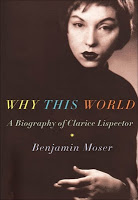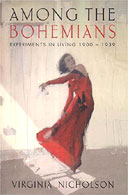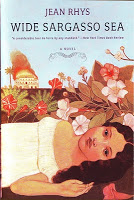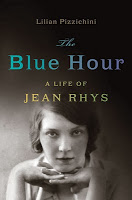Jean Rhys, today known primarily for her groundbreaking Wide Sargasso Sea (M), was born Ella Gwendoline Rees Williams in Dominica in 1890.
Her childhood was a sad, insecure time. She was alternately neglected and disliked by her parents, and terrified by the servants. She witnessed her elder siblings disappearing to live with relatives or being sent off to boarding schools. A younger sister soon arrived to replace her in the affections of (who she remembered to be) her loving mother. As a teenager, she was shipped off to a boarding school in England. Jean was unused to the cold and was mocked for her accent and her lack of comprehension of British life. She eventually found her way into the performing arts, becoming a chorus girl
The Blue Hour: a life of Jean Rhys (M) by Lilian Pizzichini describes a sad and vague Jean Rhys. She, who was rarely valued, did not value herself and slipped into a world of semi-respectable prostitution. She was both pretty and fragile and this was appealing to some men who went on to support her for many years. She had an attraction for the seamier side of life, eventually marrying two criminals. She spent the 1920’s in Paris eking out a life as best she could while beginning her writing career.
Her novels and stories were ahead of their time, often not receiving good reviews in her lifetime. Her acclaimed Wide Sargasso Sea (which she had written initially several decades earlier and destroyed) has come to be considered one of the greatest feminist novels of the 20th century. Wide Sargasso Sea is a sympathetic portrait of the tragically misunderstood Bertha Rochester – the madwoman in the attic in Jane Eyre. (Perhaps one of the first prequels/sequels to 19th century literature??- thankfully no vampires or zombies here!)
So much of Rhys’ fiction was painfully taken directly from her life. She herself was fragile, brilliant and very difficult. As she aged and lost her ingenue persona, her life was increasingly taken over by alcohol. She was incarcerated on several occasions due to public drunkenness and assaults on neighbours. She placed all her hopes and gave credit for her success to those who helped her. She became disillusioned and enraged when they inevitably let her down.
Pizzichini has written a short, but compulsively readable biography. She attempts to determine the psychological motivations of this very complicated woman. The book particularly shines in its description of Rhys in bohemian Paris in the 1920’s. Rhys was a difficult wife, mother and neighbour, but Pizzichini remains nonjudgmental and even sympathetic as she presents the details of this fascinating life with no holds barred.
Fans of literary biographies might also enjoy:
 The Talented Miss Highsmith: the secret life and serious art of Patricia Highsmith (M) by Joan Schenker -“Patricia Highsmith, one of the great writers of 20th Century American fiction, had a life as darkly compelling as that of her favorite “hero-criminal,” talented Tom Ripley. In this revolutionary biography, Joan Schenkar paints a riveting portrait, from Highsmith’s birth in Texas to Hitchcock’s filming of her first novel, Strangers On a Train, to her long, strange, self-exile in Europe. We see her as a secret writer for the comics, a brilliant creator of disturbing fictions, and erotic predator with dozens of women (and a few good men) on her love list. The Talented Miss Highsmith is the first literary biography with access to Highsmith’s whole story: her closest friends, her oeuvre, her archives. It’s a compulsive page-turner unlike any other, a book worthy of Highsmith herself.” – publisher
The Talented Miss Highsmith: the secret life and serious art of Patricia Highsmith (M) by Joan Schenker -“Patricia Highsmith, one of the great writers of 20th Century American fiction, had a life as darkly compelling as that of her favorite “hero-criminal,” talented Tom Ripley. In this revolutionary biography, Joan Schenkar paints a riveting portrait, from Highsmith’s birth in Texas to Hitchcock’s filming of her first novel, Strangers On a Train, to her long, strange, self-exile in Europe. We see her as a secret writer for the comics, a brilliant creator of disturbing fictions, and erotic predator with dozens of women (and a few good men) on her love list. The Talented Miss Highsmith is the first literary biography with access to Highsmith’s whole story: her closest friends, her oeuvre, her archives. It’s a compulsive page-turner unlike any other, a book worthy of Highsmith herself.” – publisher
 Why This World: a biography of Clarice Lispector (M) by Benjamin Moser – “That rare person who looked like Marlene Dietrich and wrote like Virginia Woolf, Clarice Lispector is one of the most popular but least understood of Latin American writers. Now, after years of research on three continents, drawing on previously unknown manuscripts and dozens of interviews, Benjamin Moser demonstrates how Lispector’s development as a writer was directly connected to the story of her turbulent life. Born in the nightmarish landscape of post World War I Ukraine, Clarice became, virtually from adolescence, a person whose beauty, genius, and eccentricity intrigued Brazil. “Why This World” tells how this precocious girl, through long exile abroad and difficult personal struggles, matured into a great writer, and asserts, for the first time, the deep roots in the Jewish mystical tradition that make her the true heir to Kafka as well as the unlikely author of perhaps the greatest spiritual autobiography of the twentieth century. From Chechelnik to Recife, from Naples and Bern to Washington and Rio de Janeiro, “Why This World” strips away the mythology surrounding this extraordinary figure and shows how Clarice Lispector transformed one woman’s struggles into a universally resonant art.” – publisher
Why This World: a biography of Clarice Lispector (M) by Benjamin Moser – “That rare person who looked like Marlene Dietrich and wrote like Virginia Woolf, Clarice Lispector is one of the most popular but least understood of Latin American writers. Now, after years of research on three continents, drawing on previously unknown manuscripts and dozens of interviews, Benjamin Moser demonstrates how Lispector’s development as a writer was directly connected to the story of her turbulent life. Born in the nightmarish landscape of post World War I Ukraine, Clarice became, virtually from adolescence, a person whose beauty, genius, and eccentricity intrigued Brazil. “Why This World” tells how this precocious girl, through long exile abroad and difficult personal struggles, matured into a great writer, and asserts, for the first time, the deep roots in the Jewish mystical tradition that make her the true heir to Kafka as well as the unlikely author of perhaps the greatest spiritual autobiography of the twentieth century. From Chechelnik to Recife, from Naples and Bern to Washington and Rio de Janeiro, “Why This World” strips away the mythology surrounding this extraordinary figure and shows how Clarice Lispector transformed one woman’s struggles into a universally resonant art.” – publisher
 Among the Bohemians: experiments in living 1900-1939 (M) by Virgina Nicholson – “They ate garlic and didn’t always bathe; they listened to Wagner and worshiped Diaghilev; they sent their children to coeducational schools, explored homosexuality and free love, vegetarianism and Post-impressionism. They were often drunk and broke, sometimes hungry, but they were of a rebellious spirit. Inhabiting the same England with Philistines and Puritans, this parallel minority of moral pioneers lived in a world of faulty fireplaces, bounced checks, blocked drains, whooping cough, and incontinent cats.” – publisher
Among the Bohemians: experiments in living 1900-1939 (M) by Virgina Nicholson – “They ate garlic and didn’t always bathe; they listened to Wagner and worshiped Diaghilev; they sent their children to coeducational schools, explored homosexuality and free love, vegetarianism and Post-impressionism. They were often drunk and broke, sometimes hungry, but they were of a rebellious spirit. Inhabiting the same England with Philistines and Puritans, this parallel minority of moral pioneers lived in a world of faulty fireplaces, bounced checks, blocked drains, whooping cough, and incontinent cats.” – publisher



